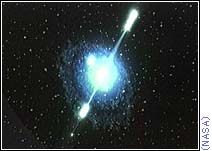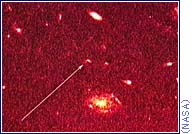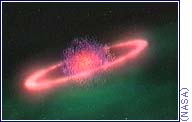Cached from
http://www.cnn.com/TECH/space/9805/06/space.explosion/
CNN May 6, 1998
Astronomers astounded by enormous explosion in deep space

In this story:
May 6, 1998
- As bright as the entire universe
- 'Brightest documented explosion in history'
- Power released is almost unimaginable
- Theoretical models can't explain it
- Related sites and stories
Web posted at: 8:37 p.m. EDT (0037 GMT)WASHINGTON (CNN) -- Astronomers are mystified by the most powerful explosion ever witnessed, an enormous burst of gamma ray energy 12 billion light years from Earth that in one second released almost as much energy as all the stars of the universe.
The explosion was too far away to affect the Earth or the sun, but the astronomers say they are astounded by the might of the blast and baffled about what might have caused it.
"The energy released by this burst in its first few seconds staggers the imagination," said Shrinivas Kulkarni, a professor of astronomy at California Institute of Technology and leader of a team that helped calculate the explosion size.
NASA animation of a gamma ray burst 836K/8 sec./320x240
235K/8 sec./160x120
QuickTime movieKulkarni is co-author of a study being published Thursday in the journal Nature. He and others appeared at a Washington news conference Wednesday.
"For about one or two seconds, this burst was as luminous as all the rest of the entire universe," said Caltech professor George Djorgovski, another member of the team. "In a region about a hundred miles across, the burst created conditions like those in the early universe, about one millisecond after the Big Bang."
"I was astounded when I heard these results," said Stan Woosley, a professor of astronomy at the University of California, Santa Cruz, and an expert on astronomical explosions. "At first I could hardly believe them, but now I'm convinced they're true, and it makes the universe bigger and more exciting than I ever thought before."
'Brightest documented explosion in history'
The gamma ray explosion came from a faint galaxy known as GRB 971214 and was first seen December 14. It is about 12 billion light years from Earth. A light year is the distance light travels in a year at 189,000 miles a second, or about 5.9 trillion miles.

NASA animation of the explosion Gamma ray bursts are common, occurring once or twice a day, but the rays are invisible and can be detected only by satellites orbiting above the Earth's atmosphere.
Since a burst lasts only seconds, astronomers rarely are able to focus telescopes on the source and measure the light necessary to calculate the size of the explosion or pin down its location.
But on the night of December 14, an Italian team detected the gamma ray burst with the BeppoSAX orbiting observatory and quickly alerted David J. Helfand, a Columbia University astronomer. Helfand relayed the information to astronomers operating telescopes at Kitt Peak near Tucson, Arizona, who were able to photograph the burst.
Later, the Hubble Space Telescope and others photographed the explosion's afterglow. Kulkarni and others analyzed the energy and light released from the object and concluded it was a very faint and distant galaxy about 12 billion light years away.
That it occurred so far away, Kulkarni said, indicated that the explosion was immensely powerful.

The arrow shows the galaxy where the explosion occurred "This was the brightest documented explosion in history," said Woosley.
Power released is almost unimaginable
Woosley said the energy released was equal to about 5 billion supernovae, the explosion of dying stars that, until this explosion, had provided the most powerful documented sudden releases of energy.
In visible light alone, Woosley said, the gamma ray burst energy was equal to about 1,000 supernovae.
By some calculations, the gamma ray burst release equaled as much energy in one second as all of the 10 billion trillion stars in the universe combined.
Woosley said it is difficult to relate the power in common terms.
For instance, he said, if all of the nuclear weapons ever made were exploded at once, the energy released would equal about 1/100,000 of a second of the energy from Earth's sun. Yet over its 10 billion-year history, Woosley said, the sun will produce only about 1 percent of the energy of the explosion.
Gamma ray bursts were unknown until the launch of U.S. military satellites designed to detect radiation from the explosion of atomic bombs. Later, scientific satellites were launched to study the bursts, but astronomers were still at a loss to explain them.
"We had no idea where they came from or what was responsible for them," said Alan Bunner, a science program director at NASA.
Theoretical models can't explain it
More than 2,000 gamma ray bursts have been recorded, but astronomers were unable until recently to pinpoint their location or measure their distance from Earth. Only three have been pinpointed so far.
Kulkarni said that all of the bursts have been located in dusty regions where stars form, suggesting that the massive explosions may play a role in the birth of new stars.

NASA animation showing an exploding star Woosley and others speculate that such an explosion may occur when a black hole swallows a neutron star. A black hole is a collapsed object that is so dense that its gravity permits not even light to escape; a neutron star is a massive collapsed star.
Astronomers believe the immense explosion sent matter, such as neutrons and electrons, streaking outward at near the speed of light. About a day later, the matter smashed into gas and dust particles, and the violence and heat of the collisions created gamma rays, X-rays, and then visible light.
It was these energy sources that were detected by the orbiting instruments and later by the telescopes.
"Most of the theoretical models proposed to explain these bursts cannot explain this much energy," Kulkarni said, adding that it might have come from a rotating black hole.
"On the other hand, this is such an extreme phenomenon that it is possible that we are dealing with something completely unanticipated and even more exotic."
Correspondent Ann Kellan, The Associated Press and Reuters contributed to this report.
Related stories:
- Pictures support theory of water on Europa - March 2, 1998
Related sites:
Note: Pages will open in a new browser window
© 1998 Cable News Network, Inc.
A Time Warner Company
All Rights Reserved.